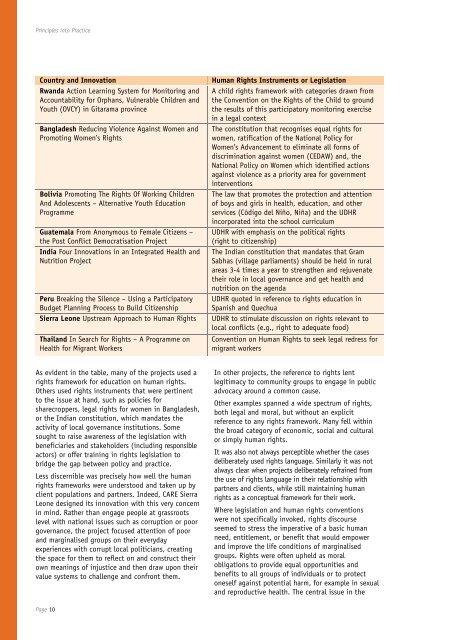Principles into Practice - Handicap International
Principles into Practice - Handicap International
Principles into Practice - Handicap International
- No tags were found...
You also want an ePaper? Increase the reach of your titles
YUMPU automatically turns print PDFs into web optimized ePapers that Google loves.
<strong>Principles</strong> <strong>into</strong> <strong>Practice</strong>Country and InnovationRwanda Action Learning System for Monitoring andAccountability for Orphans, Vulnerable Children andYouth (OVCY) in Gitarama provinceBangladesh Reducing Violence Against Women andPromoting Women’s RightsBolivia Promoting The Rights Of Working ChildrenAnd Adolescents – Alternative Youth EducationProgrammeGuatemala From Anonymous to Female Citizens –the Post Conflict Democratisation ProjectIndia Four Innovations in an Integrated Health andNutrition ProjectPeru Breaking the Silence – Using a ParticipatoryBudget Planning Process to Build CitizenshipSierra Leone Upstream Approach to Human RightsThailand In Search for Rights – A Programme onHealth for Migrant WorkersHuman Rights Instruments or LegislationA child rights framework with categories drawn fromthe Convention on the Rights of the Child to groundthe results of this participatory monitoring exercisein a legal contextThe constitution that recognises equal rights forwomen, ratification of the National Policy forWomen’s Advancement to eliminate all forms ofdiscrimination against women (CEDAW) and, theNational Policy on Women which identified actionsagainst violence as a priority area for governmentinterventionsThe law that promotes the protection and attentionof boys and girls in health, education, and otherservices (Código del Niño, Niña) and the UDHRincorporated <strong>into</strong> the school curriculumUDHR with emphasis on the political rights(right to citizenship)The Indian constitution that mandates that GramSabhas (village parliaments) should be held in ruralareas 3-4 times a year to strengthen and rejuvenatetheir role in local governance and get health andnutrition on the agendaUDHR quoted in reference to rights education inSpanish and QuechuaUDHR to stimulate discussion on rights relevant tolocal conflicts (e.g., right to adequate food)Convention on Human Rights to seek legal redress formigrant workersAs evident in the table, many of the projects used arights framework for education on human rights.Others used rights instruments that were pertinentto the issue at hand, such as policies forsharecroppers, legal rights for women in Bangladesh,or the Indian constitution, which mandates theactivity of local governance institutions. Somesought to raise awareness of the legislation withbeneficiaries and stakeholders (including responsibleactors) or offer training in rights legislation tobridge the gap between policy and practice.Less discernible was precisely how well the humanrights frameworks were understood and taken up byclient populations and partners. Indeed, CARE SierraLeone designed its innovation with this very concernin mind. Rather than engage people at grassrootslevel with national issues such as corruption or poorgovernance, the project focused attention of poorand marginalised groups on their everydayexperiences with corrupt local politicians, creatingthe space for them to reflect on and construct theirown meanings of injustice and then draw upon theirvalue systems to challenge and confront them.In other projects, the reference to rights lentlegitimacy to community groups to engage in publicadvocacy around a common cause.Other examples spanned a wide spectrum of rights,both legal and moral, but without an explicitreference to any rights framework. Many fell withinthe broad category of economic, social and culturalor simply human rights.It was also not always perceptible whether the casesdeliberately used rights language. Similarly it was notalways clear when projects deliberately refrained fromthe use of rights language in their relationship withpartners and clients, while still maintaining humanrights as a conceptual framework for their work.Where legislation and human rights conventionswere not specifically invoked, rights discourseseemed to stress the imperative of a basic humanneed, entitlement, or benefit that would empowerand improve the life conditions of marginalisedgroups. Rights were often upheld as moralobligations to provide equal opportunities andbenefits to all groups of individuals or to protectoneself against potential harm, for example in sexualand reproductive health. The central issue in thePage 10

















